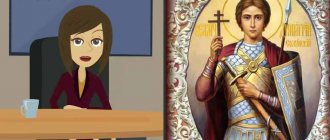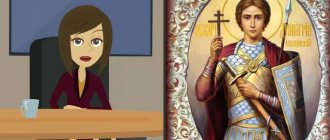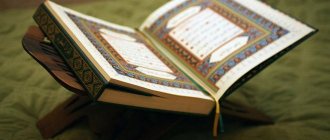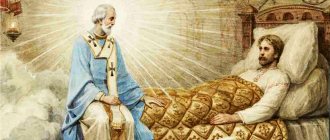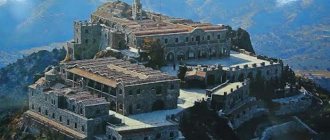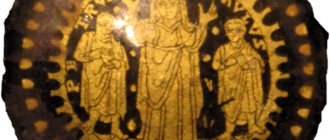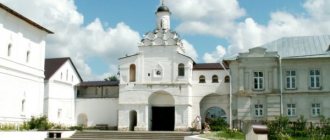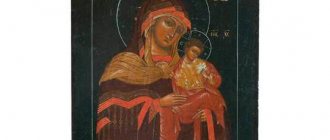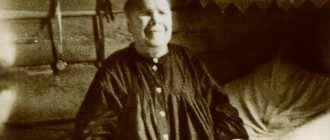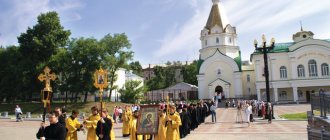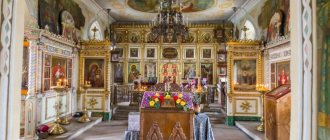The glorification of the Great Prince of Moscow Dmitry Donskoy before the saints became possible thanks to his enormous services to the Fatherland and the Church. By his pious personal example, Dmitry Donskoy showed how, for the sake of the good and salvation of others, sacrifice is made in the name of Christ. And how the Lord himself helps in pious deeds.
Demetrius Donskoy was a student of St. Alexy of Moscow and already at a young age proved himself to be a talented ruler of the state. He fought for the unity of Russian territories because he was called the collector of Russian lands. Saint Demetrius was the liberator of Rus' from the Mongol yoke. For his decisive historical battle on Kulikovo, blessed Prince Demetrius received the blessing of the great Venerable Sergius of Radonezh. The Monk Sergius gave his monks-schemers Alexei and Alexander as assistants to the blessed warrior Demetrius. Grand Duke Dimitri bravely won the Battle of Kulikovo. The history of the Russian army has never known such a victory. The Don River flows near the Kulikovo site, so the winner of the battle, Demetrius, was named Dmitry Donskoy.
Mother of God - Helper in spiritual struggle
Important!
People come to Our Lady of the Don with everyday difficulties, faced with difficult choices, and in a struggle with an internal enemy. In a sermon dedicated to the holiday of the state shrine, His Holiness Patriarch Kirill said: “Today our people are threatened by other opponents, other enemies - who do not stand in the distance... Today we allow the enemy into our home, into our personal and family life, for what is offered us through the media, via the Internet, through other instruments of influence on human consciousness, is often enemy." In a sermon dedicated to the holiday of a state shrine, His Holiness Patriarch Kirill said: "Today our people are threatened by other opponents, other enemies - who are not far away ... Today we are letting the enemy into our home, into our personal and family life, because what is offered to us through the media, through the Internet, through other instruments of influence on human consciousness, is often enemy.”
If desired, every believer can pray in front of this image for everything that worries his soul. It is not necessary to follow a strict classification for prayer in front of an icon.
Watch a video about Our Lady of the Don
Demise and veneration
Before his death, the Grand Duke made a spiritual will, commanding his children to honor their mother, Grand Duchess Evdokia (monastically Euphrosyne; † year; canonized), and the boyars to live according to the commandments of God, affirming peace and love.
Dying, Dmitry Donskoy transferred the great reign to Vasily I, his eldest son, without the consent of the Khan of the Golden Horde
Saint Demetrius died a year ago and was buried in the Archangel Cathedral of the Moscow Kremlin, next to the tombs of his father, grandfather, and great-grandfather. His death at the age of 41 shocked all of Rus'. After Vladimir Monomakh and Alexander Nevsky, the Russian people did not love or honor anyone so much. According to legend, at the funeral service among the numerous clergy was the patron, prayer book, elder of the Grand Duke, St. Sergius of Radonezh.
The Grand Duke of Moscow Dimitri Donskoy was canonized in 1988 as a blessed saint on the basis of his great services to the Church and the people of God, as well as on the basis of his personal pious life, which embodied the saving Christian idea of sacrificing oneself to the point of blood for the good and salvation of others.
Memorial Day of Dmitry Donskoy
Saint Demetrius died on June 1, 1389 , and was buried in the Archangel Cathedral of the Moscow Kremlin, next to the tombs of his father, grandfather, and great-grandfather. His death at the age of 41 shocked all of Rus'. After Vladimir Monomakh and Alexander Nevsky, the Russian people did not love or honor anyone so much. According to legend, at the funeral service among the numerous clergy was the patron, prayer book, elder of the Grand Duke, St. Sergius of Radonezh.
The Grand Duke of Moscow Dimitri Donskoy was canonized in 1988 as a blessed saint on the basis of his great services to the Church and the people of God, as well as on the basis of his personal pious life, which embodied the saving Christian idea of sacrificing oneself to the point of blood for the good and salvation of others.
Wise ruler and fearless warrior
A strong, tall, stately ruler who wore a black beard, involuntarily attracted the glances of the people around him. A special power of spirituality and holiness emanated from him; an outstanding statesman was distinguished by a special talent for peacefully settling matters, laying the foundation for stone urban planning in Moscow.
The fire of 1365 destroyed all wooden buildings, both in the Kremlin and in the lands adjacent to it. The wise ruler Dimitri begins the restoration of Moscow with the construction of stone buildings, and in 1367 the Moscow Kremlin appeared.
After the death of John the Red, the Principality of Vladimir belonged to the Prince of Suzdal. Having received a label for the reign from the temnik of the Golden Horde, young Dmitry sends the Moscow army to liberate Pereyaslav and Vladimir from Dmitry Konstantinovich.
Subsequently, Dmitry Konstantinovich nevertheless acquired the right to rule in Nizhny Novgorod, renouncing his rights to the Vladimir lands, while his daughter married the Moscow prince. At the age of 16, Dmitry marries Princess Evdokia Dmitrievna from Suzdal, and with her annexes the Suzdal lands to the Moscow principality.
Icon of Saint Prince Dmitry Donskoy
From this marriage 8 sons were born: Daniil, Vasily, Yuri, Simeon, Ivan, Andrey, Peter and Konstantin, and four daughters: Sophia, Maria, Anastasia and Anna.
The Golden Horde was on the verge of collapse. In 1365, the people of Ryazan defeated the troops of Tagai and Bulat-Timur, the people of Suzdal sided with Mamai, planting his henchmen in Volga Bulgaria in 1370. The pious and peace-loving Grand Duke Dimitri, throughout his short life, was forced to constantly guard the Russian lands and repel the attacks of enemies who wanted to enslave Rus'.
In addition to the Horde and Lithuania, internal Russian strife also threatened the peace of the Moscow principality. The Lithuanian ruler Olgerd launched attacks on the Moscow Kremlin in 1368 and 1370, only thanks to the strengthening of cannons, as a new type of defensive weapon, and the wise leadership of Demetrius, the fortress survived.
Having defeated the Tver army in 1375, the Moscow ruler entered into an alliance with the prince of Tver in the fight against the Golden Horde. The victorious battle on the Vozha River in 1378 showed that the Tatar-Mongol yoke could be defeated.
Icon Dmitry Donskoy life-size
Description:
The unifier of Russian lands and liberator of Rus' from the Tatar-Mongol yoke, the blessed Prince Dimitri Donskoy, is at the same time an outstanding historical figure and a saint of the Russian Orthodox Church. We will tell you about the life of the prince and how to pray to this saint.
| Buy a life-size icon of Dmitry Donskoy you can on our website. To do this, just place an order and we will produce it and send it to any region of Russia and the CIS countries. You can order a carved life-size icon of Dmitry Donskoy in the size you need. Check with the manager for the cost of such an order. |
Dimitry Donskoy - Memorial Day
Memorial Day of the Holy Blessed Prince Dimitry Donskoy is June 1 according to the new style (May 19 according to the old style) and October 12 (September 29). This is an everlasting holiday. On this day, Orthodox Christians prayerfully remember the name of the Grand Duke - his life, service to the Russian people, his glorious exploits.
Dmitry Donskoy - biography
The life of Dimitri Donskoy is no less than one of the most important pages in the entire history of Russia. The Grand Duke became famous throughout the centuries, firstly, as an outstanding historical figure - the unifier of Russian lands and the liberator of Rus' from the Tatar-Mongol yoke. And, secondly, as a ruler who lives and leads the country according to the commandments of Christ. He was nicknamed Donskoy for his victory in the Battle of Kulikovo, which took place between the Don and Nepryadva rivers.
The future saint, the son of Grand Duke Ivan Ivanovich, was born in 1350. He became the Grand Duke at the age of twelve - in 1362. He reposed in the Lord (that is, died) in 1389. He was canonized as a saint of the Russian Orthodox Church in 1988.
We know little about the prince’s childhood, but historical science confidently says that Saint Alexy of Moscow helped him grow in faith. In many ways, the saint replaced Dmitry the Don's father, who died when the boy was only nine. Thanks to the efforts of the teacher and thanks to his own spiritual aspirations, the prince grew up as a man devoted to Christ and the Church, firmly convinced that one must live and rule the country according to the Gospel commandments.
During the years when Dimitri Donskoy ruled the Moscow principality, this region of Rus' took on the role of a center around which other Russian lands united. Over the years, the Grand Duke's army won many glorious and politically important battles with the Mongols, for example, the Battle of the Vozha River and, of course, the Battle of Kulikovo.
Despite the fact that even after the death of Dmitry Donskoy the Golden Horde continued to raid Rus', it was his strategy of rule and his military victories that became a turning point in the centuries-old history of relations with the Horde.
In addition, during the era of Dmitry Donskoy, the majestic Kremlin was built in Moscow - then it was white stone. And also fortress monasteries - Simonov and Andronikov.
Saint Demetrius reposed in the Lord on May 19, 1389. He was buried in the Archangel Cathedral of the Moscow Kremlin.
Dimitry Donskoy - icon
Some of the first iconographic images of Grand Duke Dimitri Donskoy have survived to this day. This is the face of the saint on the frescoes in the Archangel Cathedral and in the Faceted Chamber of the Moscow Kremlin.
There is an interesting icon - “The Appearance of the Icon of St. Nicholas to Demetrius Donskoy on the Ugresh River.” The description of the 19th century banner, which is the oldest image of this iconography, has survived to this day: “The image of St. Nicholas the Wonderworker is written on the banner, in front of which the Grand Duke Dmitry Donskoy is depicted in prayer with his boyars, the headquarters is visible in the distance.”
The iconography of “The Appearance of the Icon of St. Nicholas to Demetrius Donskoy on the Ugresha River” is based on a historical event that happened to the Grand Duke on the road to Kulikovo Field in August 1380. The army followed the path along the Moscow River to prevent the impending raid of Khan Mamai on Rus', and made a stop 15 versts from Moscow. At night, the icon of St. Nicholas the Wonderworker appeared in radiance before the future saint. Dimitry Donskoy, together with other soldiers, prayed in front of the image. And the icon came down from the heights straight into the hands of the prince, he reverently kissed it and exclaimed: “This has sinned my heart!” (“This all warmed my heart!”). Since then, the place of the appearance of the miraculous icon began to be called Ugresha, now geographically it is the town of Dzerzhinsky, Moscow region.
| Carved icons are considered one of the best gifts for your loved ones and friends. Carved icons from the AVATEX® company are an excellent choice for a gift to your loved ones. Made using special equipment, they contain a piece of the soul of our craftsmen. In our catalog you will find wooden icons that you can choose as a gift for any occasion. Personalized icons, icons of saints, measured icons will take their rightful place and become a decoration for your home. |
Icons depicting Demetrius Donskoy
Moscow icon painting of the 15th century was updated with the appearance of a new image, Prince Dmitry Donskoy. The first images of the prince, in the face of the Saint, appeared during the reign of Metropolitan Alexy of Moscow. It was during this period that pictures of the meeting between the Patriarch and Prince Donskoy appeared.
On the icons painted by Alexy, the Prince of Moscow is depicted in a pious bow; there is not yet a halo above his head, but the Metropolitan is already blessing him with a cross.
The icon with sixteen terminals, painted at the beginning of the 16th century, depicts the meeting of Dmitry Ioannovich with the Monk Dmitry Prilutsky.
In 1980, during the restoration of the Cathedral of the Annunciation in the Moscow Kremlin, craftsmen restored the image of the prince standing in prayer, his son Vasily is also depicted next to him.
In 1509, an icon of Dmitry Donskoy was painted with a halo above his head; before that he was depicted without it. The halo on icons above the Saints is depicted according to Byzantine traditions.
On authentic images of the 18th - 20th centuries. the prince is depicted with gray curly hair, with a beard, dressed in princely clothes, namely in a red or blue fur coat and with a sword in his hands. The scenes on the icons tell about the life of the ruler.
The best article for you, go to: Icon of the Optina Elders
The prince was canonized by the Orthodox Church in 1988. Painted icons of the great defender allow people to recognize the lifetime appearance of a warrior who went down in world history as a strong-willed ruler and noble prince, who strove with all his might to unite the Russian lands and protect his native land.
A sword in the hands of a warrior has two meanings:
· military purpose - to defeat the enemies of the Fatherland;
· spiritual - in the salvation of Christianity through the power of psalms and prayers near holy images.
Modern icon painters have expanded their understanding of the image of the knight, the defender of the homeland, depicting his holy face against the backdrop of cathedrals.
The meaning of the icon “Blessed Prince Dimitri Donskoy”
The icon of Dmitry Donskoy is often depicted against the backdrop of churches and holding the temple in his hand. The significance of this background suggests that Prince Saint Demetrius made significant efforts to secure freedom from Constantinople for the Russian Orthodox Church. During his reign, many temples and monasteries were built. Currently, they are an effective spiritual defense of the borders of the Motherland from external enemies.
At the request of Grand Duke Demetrius, memorial services were constantly held in churches in memory of the fallen soldiers. Blessed Prince Demetrius became the founder of new traditions in the history of the church charter. This is the memorable Saturday of Demetrius and another miracle, an event associated with the discovery of the relics of the famous holy warrior Alexander Nevsky.
The relics of Alexander Nevsky are kept in the Vladimir Assumption Cathedral, and on the night before the battle of Prince Demetrius with the Mongols, the temple servants saw two elders emerge from the altar, dressed in the vestments of metropolitans. They approached the grave of Alexander Nevsky and said: “Get up to Alexandra, be ready to help your great-grandson, Grand Duke Dmitry, who is overcoming his existence from strangers.” Prince Alexander Nevsky rebelled and the vision disappeared.
Miracles of the Great Martyr
About the silver throne
Many miracles occurred at the relics of the saint, but only the most striking and memorable ones have reached us.
One day there was a fire in the temple built in honor of the great martyr. The strong flame melted the silver canopy over the shrine of St. Dimitri. The Archbishop of Thessaloniki in those years was Bishop Eusebius, who was going to restore the cover. However, he had very little silver for this.
Also in the same temple there was a silver throne, which remained completely undamaged after the fire. The archbishop decided to transfer the throne to the cover for the saint's shrine, but at the same time did not yet notify anyone of his intention. At the same time, there was one God-fearing presbyter named Dmitry at the church. The Holy Great Martyr appeared to him three times with the same words: “Go and tell the bishop that I myself will take care of the city and my church, and that he should leave me in charge of them. Therefore, let the throne not overflow.”
The pious Christian obediently conveyed the words of the saint to the archbishop, but he only listened to the words conveyed for the third time and ordered not to overfill the throne. Soon a citizen of Thessaloniki, whose name was Mina, appeared at the temple and donated 75 pounds of silver. He expressed the desire that this precious metal be used for a canopy over the saint’s shrine. After this, other citizens of Thessaloniki also came and brought silver in the same way. From the donations collected, a magnificent cover was made over the shrine of the Great Martyr Demetrius.
About the siege of the city
When Emperor Mauritius came to power, the Avars living on the Don besieged the city of Thessaloniki. The Monk Demetrius appeared on one of the city walls and, striking with a spear, threw off the wall the first of the enemies who climbed there. Falling, he dragged the other attackers along with him, and the hundred-thousand-strong army of the besiegers rushed away from the city in horror. However, after some time the enemy came to his senses and laid siege to the city again.
At that time, a certain righteous resident of Thessaloniki named Illustrius fervently prayed in the temple of the Great Martyr Demetrius for the liberation of the city from its opponents. Suddenly he saw two angels who entered the temple and headed towards the tomb of the great martyr. At their call, Demetrius, as the story goes, “came forth in his likeness,” while, the narrator clarifies, “his face shone brighter than the sun’s light.” The welcoming angels “kissed him” and conveyed the command of the Almighty Lord to leave Thessaloniki, since Thessaloniki “will be taken by the filthy.”
We advise you to study the Prayer “I Believe in One God, the Father Almighty”
Saint Demetrius began to cry, saddened, and asked to tell the Vladyka that he could not leave his hometown in such trouble and see its death, standing on the sidelines. The saint boldly answered the heavenly messengers: “If you destroy Thessaloniki, then I will perish with it; If you deliver, then I will be delivered with him.” The angels were disappointed with the decision of the great martyr and left, warning him that for disobedience he would face the wrath of God. The saint lay back in the tomb.
The next morning, Illustry told his fellow citizens about what he had witnessed. They were very encouraged and rejoiced that their heavenly intercessor was with them. After a week of siege, the enemies fled for no apparent reason, abandoning both their throwing weapons and tents.
About help in hunger
When the siege of the city was lifted, it turned out that all the grain reserves in the city were destroyed, and famine struck in Thessaloniki.
The Great Martyr appeared more than once on ships sailing the sea, went around the islands and piers, commanding ships everywhere with wheat to go to Thessaloniki. Thus, the city was saved by Saint Demetrius from famine.
Miracle of the relics
When the pious ruler Justinian built a magnificent temple in Constantinople in honor of Sophia the Wisdom of God, he sent honest men to Thessaloniki to bring from there some part of the relics of St. Great Martyr Demetrius for the decoration and consecration of the newly erected temple. Arriving in Thessaloniki, the king's envoys approached the sacred shrine, in which the relics of the great martyr rested, in order to fulfill the royal command.
Suddenly, a stream of flame burst out of the shrine, showering everyone present with a stream of sparks, and a voice came from the fire: “Stop and don’t dare touch me.” All who witnessed this miracle fell on their faces, filled with awe; After this, the royal envoys, having taken only a little land near the place where the holy relics were, returned to the ruler and told him about everything that had happened to them. Everyone who listened to the story was shocked. The envoys handed over half of the brought land to the ruler, and the remaining part was placed in the temple container.
How they portray
Artists
Many Russian painters turned to the theme of the heroic battle on the Kulikovo Field.
Ilya Glazunov
In 1962, the artist began painting a number of canvases united by the theme of the Battle of Kulikovo. This work continued for 30 years.
Ilya Glazunov. Eve. Sergius of Radonezh and Dmitry Donskoy before the Battle of Kulikovo. From the series “Kulikovo Field”. Option-repetition. 2004
Painting "Prince Dmitry". The artist depicts Dimitry Ioannovich before the battle. The prince's face is calm and expresses confidence. However, the crimson color of the cloak and the sharp spears behind his back convey the general anxiety of the plot of the composition. The high mission of the Russian soldiers is figuratively emphasized by the background of the canvas chosen by the master, which represents a cloudy blue sky, symbolizing the purity and nobility of the goal of those fighting for the freedom of the Fatherland.
“They found Prince Dmitry”
Another painting from the “Kulikovo Field” series. The plot of the film is based on the events that occurred after the battle, when a wounded prince was found among the fallen soldiers.
The artist himself explains that in his creations he sought
Ilya Glazunov. Cycle “Kulikovo Field”. Dmitry Donskoy. 1980.
“St. Sergius blesses Demetrius Donskoy”
The painting was painted by the painter in 1882. At that time, he was completing his studies in the life class of the St. Petersburg Academy of Arts. For this programmatic work, which reliably reproduces the events of that distant era, the exact setting and psychological portrait of the participants, Alexander Nikanorovich Novoskoltsev received a large academic medal.
At the beginning of the 19th century. The professorship of the Academy of Arts proposed this topic to its graduates as a thesis. Orest Kiprensky then received a gold medal for the painting “Dmitry Donskoy on the Kulikovo Field,” created in 1805.
Vasily Sazonov
In 1824, a canvas with the same name was depicted by the artist Vasily Sazonov. Although his work was not realistic and did not fully correspond to the national color, it forever entered the golden fund of works of Russian academic painting.
Temple paintings
Franz Nikolaevich Riess
In the middle of the 19th century, the Russian painter Franz Nikolaevich Riess completed some wall paintings in the northwestern part of St. Isaac's Cathedral, including a depiction of a majestic scene of the blessing of Demetrius Donskoy by Abbot Sergius of Radonezh. This work of the great master adorns St. Isaac's Cathedral to this day.
Yvon Adolphe
Adolf Yvon. Battle of Kulikovo Field, 1850
In 1850, by order of Nicholas I, the French battle painter Yvon Adolphe created a monumental canvas called “The Battle of the Kulikovo Field”, the central part of the composition of which is occupied by the image of St. Prince Demetrius in the midst of the battle. It was planned that this creation would decorate the lower corridor of the Cathedral of Christ the Savior, but events changed, and today the painting adorns the flight of stairs leading to the St. George Hall of the Grand Kremlin Palace.
Frescoes
Annunciation Cathedral of the Moscow Kremlin. On the pillars above and below the illustrations of the Apocalypse are figures of saints - Byzantine emperors and Russian princes, including Prince Dimitri Donskoy and his son Vasily. Work of Pskov craftsmen commissioned by Ivan III Vasilyevich, 1484-1489.
The oldest fresco depicting the prince together with his son Vasily is located in the Annunciation Cathedral of the Moscow Kremlin. It was made at the beginning of the 16th century. artist Feodosius. A later fresco, created in the second half of the 16th century, is located on the southern wall of the Archangel Kremlin Cathedral. On it, Dimitri Ioannovich is presented among other Moscow rulers.
The image of the prince can be seen on a fresco of the late 17th century. in the Transfiguration Cathedral of the Novospassky Monastery, as well as on the central vault of the front vestibule of the Moscow Historical Museum. The last image was made in 1883 by the artel of F.G. Toropova.
Having become one of the eight most significant figures in national history, Dmitry Donskoy is represented on the middle tier of the monument “Millennium of Russia”
Folk traditions on April 6 (St. Artemy of Thessaloniki Day)
Most of the rules of this day are related to the upcoming Annunciation. People prepared for the good news, waited for it, and visited churches. In the church they not only prayed, but also illuminated the seed, hoping for a future harvest. It was believed that attending the all-night service on this day was mandatory for unmarried girls. In this way, you can earn the favor of heavenly patrons and count on finding a spouse soon. Also on this day they tried to clean the house in order to meet the good news in cleanliness.
Good deeds were welcomed. Folk traditions on April 6 involved the distribution of alms, including the transfer of gifts to prisoners in prisons. In this way, people hoped to pray for their deeds and, by repenting during the service, receive forgiveness.
In the ancient Slavic calendar, “Selevkiysky” was written as “Seleoukinsky”, from which “Selounsky” came. However, in some Greek monuments the saint is called Thessalonica. Saint Artemon (or Artemy) was designated in monthly books either as Seleucia or as Thessalonica. In the second half of the 17th century, these two names were mistakenly attributed to different persons. Saint Artemon (Artemios) was born and lived in Seleucia of Pisidia (Asia Minor). Pisidia is a province in the south of Asia Minor, originally part of Pamphylia; it was a harsh, mountainous region, but in some places fertile. The inhabitants of Pisidia were pirates and engaged in robbery. Of the cities of Pisidia, Antioch is especially remarkable in church history, where St. preached the Gospel. Apostle Paul (Acts 13, 14‒50). Here, in Seleucia, the future saint received his education. He led his pious life during the time of the holy apostles, who enlightened the world with the teachings of Christ. At the time when the holy Apostle Paul came to this city, Artemon, of all the citizens, turned out to shine with good deeds, like a lamp that could not remain hidden. He was pious and virtuous, therefore the holy Apostle Paul, having come to Seleucia, installed Saint Artemon, as confirmed in the faith of Christ and filled with Divine wisdom and as the most worthy, appointed the people as a shepherd and teacher, ordaining the first bishop of Seleucia of Pisidia. Saint Artemon wisely, well and godly cared for the flock entrusted to him and gained fame as the intercessor of the poor and persecuted, he was a haven of salvation for everyone, for widows, orphans and the poor he was an outstanding trustee, a miraculous healer of both soul and body. Having spent his entire life piously and pleasing to God, he died at a very old age. Brief Greek lives of Artemon are contained in the Minology of Basil II, in the Synaxarion of the Church of Constantinople of the 10th century, as well as in the Imperial Minology. The earliest evidence of the veneration of St. Artemon in Rus' - a mention of his memory in the monthly book of the Mstislav Gospel of the late 11th - early 12th centuries. The observance of Saint Artemon in Russian service Menaions is unknown, but it is found in the Bulgarian festive Menaion of the second half of the 14th century. The Russian Menaion of the 12th century includes a canon entitled “The Hieromartyr Arthemon, Bishop of Seleucia,” but referring to the Hieromartyr Artemon of Laodicea. In the first edition of the non-stichic Prologue, the translation of which was carried out in Rus' in the first half of the 12th century, the short life of the saint is placed under March 22; in the second edition, compiled at the end of the 12th century, under March 24. Hymnography. According to one of the Greek manuscripts of the Byzantine period there is an anonymous canon to Saint Artemon in the 4th tone without an acrostic; beginning ‒ “Τὸν ἐν ἀσκήσει, ὡς ἐν θαλάσσῃ” (Greek: “In exploits, as in the sea”). In the modern liturgical practice of the Orthodox Churches, the following of St. Artemon is not sung. In the printed Menaion, now used in the Greek Churches, according to the 6th canon of the Matins canon, there is a verse synaxarion of St. Artemon. Iconography. Depicted in holy vestments (felonion, omophorion), with a codex in his hands: on a fresco in the Assumption Cathedral in Vladimir, c. 1189 ; on the Vologda menaion icon for March, end. XVI century (VGIAHMZ); on an 18th century icon (Icon Museum of Recklinghausen). In the iconographic original of S. T. Bolshakov (XVIII century) under March 24 about St. Artemona is told: “Grey haired, bald, Athanasius’s brada, at the end split in two, vestments, crosses, cinnabar, amphorae and the Gospel” (p. 83).
We recommend studying Psalm 99
About Dmitry Donskoy and Feofan the Greek
According to the peculiarities of its iconography, the icon of the Don Mother of God is one of the variants of the Mother of God “Tenderness”. Most likely, this image has Greek roots.
It is believed that the most ancient image of the Don Mother of God was created by Theophan the Greek around 1392 for the Assumption Church erected by Dmitry Donskoy in Kolomna. In the middle of the 16th century, the Kolomna icon was allegedly transferred to Moscow. According to another version, Theophanes the Greek painted the icon in Moscow from the lost Kolomna original.
However, tracing the early history of this image in Rus' is very difficult - after all, the icon acquired its current name relatively late. The fact is that Grand Duke Dimitri Ivanovich received the now familiar nickname “Donskoy” only in the official historiography of the mid-16th century. Only after this did the Assumption Kolomna Church, built by him, and the icon kept there begin to be called the same. And therefore, it is often not possible to understand exactly which image of the Mother of God is meant in earlier chronicles and records.
Don Icon from the Great Cathedral of the Donskoy Monastery
What does the icon of Dmitry Donskoy help with?
Historians pay attention to the high moral qualities of Grand Duke Demetrius, his reverence for God and fortitude became an unshakable wall for external enemies.
This image helps to show willpower and fearlessness.
A prayer appeal to the icon of St. Demetrius of Donskoy helps:
- solve and resolve problems related to political issues;
- resolve issues of government procurement;
- in the resolution of armed conflicts.
The icon of St. Demetrius will be useful to those who occupy positions of highest state importance, diplomats and politicians. In his life, Prince Dimitri, despite his status as a military leader and the severity of military operations, showed generosity, mercy and kindness towards his subordinates.
People pray to the icon of Demetrius Donskoy not only about big global problems. He is asked to help create a strong Christian family. The personal married life of Saint Demetrius was an example to follow. He passed on to his children his deep respect for their mother. The icon of St. Demetrius of Donskoy also helps in our difficult times to protect the house from unwanted intrusion.
The day in honor of Saint Prince Dimitry Donskoy is celebrated on June 1.
Who painted the icon for the Kolomna church
The time and place where the icon was painted is hidden in the darkness of time. Icon painters preferred to remain anonymous, knowing that they were only an artistic instrument in the hand of God. However, the painstaking work of modern art historians suggests that the image belongs to the brush of a famous icon painter of the late 14th century. Theophanes the Greek.
Theophanes the Greek. Icon of Our Lady of the Don
Theophanes arrived in Rus' from Byzantium to decorate churches modeled on the churches of Constantinople. The time was alarming: the Golden Horde, led by Mamai, was preparing to punish Prince Dmitry Ioannovich for refusing to pay increased tribute, and at the same time destroy the Christian churches hitherto tolerated by it and convert the people to a different faith.
In preparation for the decisive battle, the troops gathered in Kolomna near Moscow, from where they marched to the Don. With them they carried the icon of the Mother of God “Eleusa”, which in Greek means “Merciful”. Presumably, it was written by Theophanes the Greek shortly before the glorious events, for the Assumption Church in the village. Kolomna. The image was mounted on a high shaft; on its reverse side the scene of the Dormition of the Mother of God was depicted.
Blessed Grand Duke DMITRY DONSKOY (†1389)
Blessed Grand Duke Dimitri Donskoy, son of Prince John the Red and Princess Alexandra, grandson of John Kalita, was born on October 25, 1350 and was raised in love for God and the Holy Church under the leadership of Saint Alexy of Moscow. The Venerable Sergius of Radonezh assisted the saint greatly in the upbringing of the prince. From an early age, Dimitri, listening to his father’s stories about his glorious ancestors - Alexander Nevsky, Daniil of Moscow and other noble princes, strengthened his responsibility for his origins.
In 1359, his father died when Dmitry was 8 years old, and he became the Grand Duke of Vladimir and Moscow. Saint Alexy actually replaced his father for a long time, until his death in 1378. As a 9-year-old boy, Dimitri went to the Horde and received permission from the khan to inherit his father’s reign.
The Grand Duke-Youth comprehended the science of Moscow politics, which consisted in a combination of strength and mercy. Under the guidance of the Metropolitan, the prince gradually acquired that special wisdom of a state ruler, which his contemporaries associated with his personality. He was strong, tall, broad-shouldered and heavyset, had a black beard and hair, and an attractive look. Life reports that Dmitry was distinguished by piety, gentleness and chastity. The Christian piety of Saint Prince Demetrius was combined with the talent of an outstanding statesman.
In 1365, the Great All Saints Fire occurred in Moscow, so named because it began in the Church of All Saints. In 2 hours the fire destroyed the Kremlin, Posad, Zagorodye and Zarechye. The Kremlin was made of wood back then. This led to Prince Dmitry starting white stone construction.
Moscow Kremlin under Dmitry Donskoy. A.M. Vasnetsov
Under him, in 1367, the first stone Kremlin in Moscow was built and guns were placed on the walls - the newest weapons of that time.
Already at the dawn of his reign, Prince Dmitry begins work to unite the Russian lands under the leadership of Moscow. In 1366, he strengthened the alliance with Suzdal, which ended with the marriage of Grand Duke Dimitri and Suzdal princess Evdokia Dimitrievna. Dmitry and Evdokia had 12 children:
- Daniel (1370- September 15, 1379)
- Basil I (September 30, 1371 – February 27, 1425)
- Sophia (†1427) - in 1402 she married Fyodor, the son of Oleg of Ryazan
- Yuri Zvenigorodsky (November 26, 1374 – June 5, 1434)
- Maria (†May 15, 1399) - married the Grand Duke of Lithuania, Lugvenius, son of Olgerd
- Anastasia - married Ivan Vsevolodovich, Prince Kholmsky
- Simeon (†11 September 1379)
- Ivan (†1393)
- Andrei Mozhaisky (August 14, 1382 – July 9, 1432)
- Peter Dmitrovsky (July 29, 1385 – August 10, 1428)
- Anna (born January 8, 1387) - married Yuri Patrikeevich, Starodubsky boyar
- Constantine (May 14, 1389 – 1433)
The Life of the Holy Blessed Prince Dmitry Donskoy
In 1359, his father died when Dmitry was 8 years old, and he became the Grand Duke of Vladimir and Moscow. Saint Alexy actually replaced his father for a long time, until his death in 1378.
As a 9-year-old boy, Dimitri went to the Horde and received permission from the khan to inherit his father’s reign. Dimitry Donskoy was a pupil of St. Alexy of Moscow.
As already noted, in Orthodoxy Dmitry Donskoy is considered the patron saint of marriage. However, he had never even seen Evdokia before marriage - it was a marriage of convenience. Sergei Radonezhsky helped in choosing a wife. The alliance with Suzdal was supposed to help Moscow strengthen on the Nizhny Novgorod side. At the time of marriage, he was 16 years old, and the bride was only 13 years old.
Many believe that this marriage owes much of its extraordinary harmony to the meek disposition of Prince Dmitry. He inherited his love of peace from his father, nicknamed “The Meek” for his diplomatic approach. Subsequently, his mentors, Metropolitan Alexy of Moscow and Abbot Sergius of Radonezh, helped him develop this character trait.
For his decisive historical Battle of Kulikovo, the blessed Prince Dimitri received a blessing from the great Saint Sergius of Radonezh. The Monk Sergius gave the faithful warrior Demetrius his schema-monks Alexei and Alexander as assistants.
The Battle of Kulikovo was valiantly won by Grand Duke Dimitri. The history of the Russian army has never known such a victory. The Don River flows next to the Kulikovo Field, which is why the winner of the battle of Dimitri began to be called Dimitri Donskoy.
God's chosen one was brought up in virtue and purity from infancy, absorbing the atmosphere of Christian morality. Never again will the great ruler deviate from the tenets of Orthodoxy.
Boundless trust in God, strict fasts, prayerful and spiritual deeds were combined with mercy and charity, care for his subordinates and the Russian people.
In 1365, All Saints Fire occurred , so named because it began in the Church of All Saints. In 2 hours the fire destroyed the Kremlin, Posad, Zagorodye and Zarechye. The Kremlin was made of wood back then. This led to Prince Dmitry starting white stone construction.
Dmitry Donskoy died young - he was not even 39 years old - just a few days after the birth of his youngest son.
Who blessed Dmitry Donskoy for the Battle of Kulikovo
Contemporaries honored the noble prince as a fearless and wise commander. Crushing victories over the Horde gave hope of getting rid of the long-term yoke.
But Saint Dmitry Donskoy did not begin a single business without God’s guidance. And therefore, going to the decisive battle of Kulikovo, he takes the blessing of St. Sergius of Radonezh. The elder exhorted them to maintain courage, trust in God, and then the Lord would grant success.
Supported by the support of the saint and his monastic warriors, the prince promises to build a monastery in the name of the Most Holy Theotokos in honor of the victory over the Mongols. At the same time, a miracle happens. The discovery of the incorruptible relics of Alexander Nevsky, the great-grandfather of the holy prince, was reliable evidence of God's help.
In honor of the crushing defeat of the Mongols, the true son of the church was named Donskoy.
Why is Dmitry Donskoy canonized?
Until the end of his days he fought for his homeland, and was canonized in 1988 as a defender of the faith and the Fatherland. He laid the foundation for the liberation of the Orthodox land from infidels.
1380, Feast of the Nativity of the Virgin Mary - a great many Orthodox soldiers were killed on the Kulikovo Field. Mourning the fallen warriors, the Grand Duke was even more inspired by the thought of uniting the Fatherland. This is what he strived for, despite the obstacles and dangers, significantly expanding the territory of the Moscow Principality.
The far-sighted and brave ruler entered into an alliance with the Suzdal princess Evdokia, bringing Veliky Novgorod under the auspices of Moscow. In pious union, 12 children were born. His Christian family was a symbol of God-fearing marriage.
He entered the history of the people as an active temple builder. He established Dmitrievskaya Parental Saturday as a tribute to the soldiers who did not return from the field.
Results of the reign of the blessed prince Dmitry Donskoy
During his 30-year reign, Dmitry Donskoy managed to become a collector of Russian lands (“bringing all Russian princes under his will”) and the recognized head of anti-Horde politics in Rus'. Dmitry also sought recognition of the independence of the Russian Orthodox Church from Constantinople.
Under him, fortress monasteries were erected (Simonov, Andronikov), which covered the approaches to the center of Moscow. For the first time in Russian military history, Dmitry introduced a new (territorial) principle of formation instead of the old principle of recruiting troops. Under Dmitry Donskoy, silver coinage was introduced in Moscow - earlier than in other Russian principalities and lands.
The meaning of the icon of Dmitry Donskoy
The holy image of Prince Dimitri Donskoy is a Christian shrine that helps in days of difficult trials and spiritual upheavals, glorifying the feat of the saint who laid down his life to defend his native country.
Orthodox Christians celebrate the Day of Remembrance of the Grand Duke of Moscow Dmitry Donskoy on June 1.
Dmitry Donskoy ruled in the second half of the 14th century - it was a time of constant internecine warfare and constant raids by soldiers of the Golden Horde.
He is an invincible military leader, an excellent strategist who forever expelled the hated Khan Mamai from Russian lands, and went down in the history of Rus' as the winner in the Battle of Kulikovo.
The prince often turned to God with prayers so that bloodshed would stop in the country, and also built temples similar to fortresses.
The best article for you, go to: St. Tikhon Belavin, Patriarch of Moscow
Deep faith, mercy and piety are the main character traits of the prince; prayers in front of his icon bring help to those who ask.
The meaning of the holy face
The icon of Prince Dimitri Donskoy is a Christian shrine that helps in days of trials and spiritual upheavals, glorifying the feat of the saint who laid down his life to defend his native land.
Icon of Saint Prince Dmitry Donskoy
Orthodox Christians pay tribute to the memory of the Grand Duke of Moscow Dimitri Donskoy on June 1.
- He ruled in the second half of the 14th century, it was a time of internecine wars and constant raids of the Golden Horde.
- An invincible military leader, an excellent strategist, he decided to forever expel the hated Khan Mamai from Russian lands and entered the history of Rus' as the winner of the Battle of Kulikovo.
- Trying to stop the bloodshed within the country, the prince often turned to prayer books and God for help, while erecting temples resembling fortresses.
Deep faith, mercy and piety are the main character traits of the saint, whose prayers at the icon bring help in what is asked before them.
Angel Dmitry Day: date
Before canonization, at a meeting of the public council dedicated to the opening of a monument to the prince in Kolomna, people far from Orthodoxy began to argue that the statue should not indicate holiness, but only that he was an excellent commander, and the rest is a private matter of the Church. However, the Orthodox participants did not agree with this.
Arguing on the topic of “the day of the angel Dmitry,” it is necessary to note the fact that Prince Dmitry Donskoy, as a great strategist and a real hero who led the Russian army, was a deeply religious person. Before entering the battle, he prayed furiously. And he was guided by faith, which led to a readiness to fight and, if necessary, suffer for the faith of Christ.
We advise you to study the Akathist to the Most Holy Theotokos in front of the “Inexhaustible Chalice” icon
Speaking to his army, he called on the soldiers to fight for their faith, for God’s churches, for children, old people and wives. The glorious warriors answered that they were ready to “lay down their lives” for Christ and receive a second baptism with their shed blood.
This is far from the only reason for the canonization of the saint. Another merit was that he became a “collector” or, as the chronicle states, “holder” of Russian lands. Without uniting the fragmented principalities, he would not have gathered a huge army that would have been able to fight the numerous horde of Mamai.
Alexander Nevsky: what does an icon help with?
Orthodox Christians pray in front of the icon for the acquisition of courage and wisdom, courage and valor, for self-sacrifice for the sake of a higher goal. Alexander Nevsky is the patron saint of all soldiers who wear his icon under their hearts, so that the holy commander protects the person with his prayers.
They did not forget about those exploits during the Second World War - the aviation squadron was named with a glorious name with the inscription “Alexander Nevsky” on board. There is a Soviet and Russian military order for special merits, bearing the name of the saint.
The enormous popularity of the blessed prince goes beyond the borders of the current Russian state: the Orthodox peoples of Serbia, Greece, and Georgia pray to him for the preservation of their borders and build churches in his honor. This gives hope for strengthening relations and increasing cooperation among Orthodox people around the world.
The meaning of the Don Icon
The Don Icon of the Mother of God is of great importance in Orthodox Christianity. It is believed that the holy face protects and protects from misfortunes and troubles, including invasions of enemy troops. The shrine has more than once acted as an intercessor and patroness of the warriors of the Russian land.
It is known that Ivan the Terrible himself knelt before the face of the Mother of God while setting out on the Kazan campaign in 1552. In 1591, the Crimean Tatars invaded Russian lands and settled near the Sparrow Hills. Not relying on their own strength, Orthodox soldiers made a religious procession around Moscow with the icon of the Mother of God “Donskaya”. In a difficult battle with the Tatars, which lasted more than a day, the Russian soldiers won.
History of the Don Icon
In 1591, hordes of the Crimean Khan Kazy-Girey invaded the Russian lands. They approached Moscow at a time when many of our soldiers were near Novgorod, repelling the attacks of the Swedes. Having placed colorful tents on the Sparrow Hills, they prepared for the decisive battle for the Kremlin... At that time, the son of Ivan the Terrible, the quiet and pious Fyodor Ioannovich, reigned in Rus'. “Let the patriarch and metropolitans carry the Don image of the Mother of God around the city walls,” Tsar Fedor gave the order, no longer relying on the force of arms, but on the intercession of the Queen of Heaven. “And when the battle begins, place the miraculous icon among the army.” “Let it be done according to your word, sir,” answered the boyars. — The Don Icon on the Kulikovo Field helped Grand Duke Dmitry defeat the enemy. After being silent for a minute or two, the king said: “At night, after fervent prayer, I heard a voice.” The Mother of God promised Her help... The battle began. The enemy rushed towards the Russians with ferocity. The battle lasted the whole day. And then the incredible happened - the ranks of the enemy, who outnumbered the Russians, wavered. Leaving their weapons and wounded in panic, they suddenly ran away, as if some unknown force had driven them. The Russians knew what was going on and who stood up for Moscow. In memory of the miraculously granted victory, it was established to celebrate the icon on August 19 (September 1, new style). And Tsar Fyodor Ioannovich ordered in the same 1591 to found a monastery on the site where the Don Icon of the Mother of God was located during the battle. The monastery was named Donskoy after the icon. In 1646, the Crimean princes invaded Russian lands. Tsar Alexei Mikhailovich, in order to avert the threat looming on Moscow, prayed before the Donskoy Icon of the Mother of God in the Annunciation Cathedral of the Kremlin, and then went with the procession with the icon to the Donskoy Monastery. The enemy was defeated in the same month on Kursk land. And in 1686 - another battle with the hordes of the Crimean Khan. This time the Don Icon accompanied Prince Golitsyn. Upon returning from a successful campaign, the holy image was greeted by the future Emperor Peter I, along with his brother Ivan and Princess Sophia. The icon returned to the Annunciation Cathedral of the Kremlin. A copy was placed in the monastery. It was written in the 16th century. This image is still located in the iconostasis of the main church of the Donskoy Monastery - the Great Cathedral in honor of the Don Icon of the Mother of God. It is located in the local row of the iconostasis, to the right of the Royal Doors, decorated on all sides with fresh flowers. This icon is also known under the name “Donskaya-Monastery”. In addition to it, the Donskaya Cathedral icon became famous in Moscow. Contemporaries did not distinguish these images by the power of the grace poured out. On Palm Sunday 1925, Patriarch Tikhon was buried in the Donskoy Monastery. The holy patriarch loved the Donskoy Monastery and spent his last years on the land consecrated by the miraculous image of the Mother of God. He was buried in the Small Donskoy Cathedral, where only a few bishops were allowed. The wise shepherds of the Church buried the saint in such a way that the security officers, who wished to soon destroy the holy relics of Tikhon, could not find his tomb. Two years later the monastery was closed. In Moscow they began to say that the relics of the patriarch were taken out of the monastery and burned. Thank God it was just rumors! Under the protection of the Mother of God, the incorrupt relics of the holy Patriarch Tikhon survived. On February 19, 1991, two years after Saint Tikhon was canonized, his relics were found in the Small Cathedral of the Donskoy Monastery. Having lain in the ground for 67 years, they did not decay. Only the silver-clad bone panagia on the saint’s chest turned to dust. Since 1930, the Donskaya Cathedral icon has been kept in the Tretyakov Gallery. And only on September 1 it is transported to the Donskoy Monastery for the worship of believers.
(Source: A. Ananichev. Don Icon of the Mother of God. Book-gift. Series “Shrines of Russia”. LLC “Publishing House “ROSMEN-PRESS”, 2005)
Features of iconography
Early images of the prince are found mainly in hagiographic images of other famous ascetics of that period: the monks Sergius of Radonezh and Demetrius of Prilutsk. Single images before the canonization of the commander are little known.
Interesting fact
A significant part of the saint’s plot compositions are associated with his glorification as a hero of the Battle of Kulikovo. Such images either depict scenes of battle directly, or emphasize the exceptional piety of the prince, thanks to which he won the victory: prayers in the Assumption Cathedral and at the tomb of St. Peter, his conversation with St. Cyprian, a visit to St. Sergius of Radonezh, and the like.
At the end of the 19th century. Another plot appeared in the iconography of the saint. It was based on a legend about the appearance in 1380 of Dmitry Donskoy in the village. Ugresha icon of St. Nicholas the Wonderworker. Subsequently, by order of the Nikolo-Ugreshsky Monastery, numerous miniature images were created depicting this wonderful event as relics for pilgrims.
Saint Demetrius of Rostov
For all Orthodox Christians, he remains an example of a holy, ascetic, non-covetous life. Upon his death, which followed on October 28, 1709, no property was found on him except books and manuscripts.
The canonization of Saint Demetrius, Metropolitan of Rostov, took place on April 22, 1757. His celebration was also established on September 21, the day the relics were found.
PRAYERS OF ST. DMITRY OF ROSTOV
God! Let all my desire and sighing be in You. May all my desire and zeal be in You alone, my Savior! Let all my will and my thoughts deepen in You, and let all my bones say: “Lord, Lord! Who is like You, who can compare with Your strength, grace and wisdom? “Thou hast arranged all things wisely, righteously, and kindly for us.”
* * *
Let nothing separate me, let nothing separate me from Thy Divine love, O my God! May he cut through nothing, neither fire, nor sword, nor famine, nor persecution, nor depth, nor height, nor present, nor future, but let this alone abide in my soul. May I desire nothing else in this world, O Lord, but day and night may I seek You, my Lord: and may I find, receive eternal treasure, and may acquire wealth, and may I be worthy of all blessings.
Stop, man!
(From the works of St. Demetrius of Rostov)
Why, man, did you leave me? Why did you turn away from the One who loved you? Why did you become the slave of My enemy? Remember that for your sake I came down from heaven.
Remember that for your sake I was born of a Virgin. Remember that for your sake I was a Baby. Remember that I humbled myself for your sake. Remember that for your sake I became poor. Remember that I lived on earth for you.
Remember that you endured persecution for your sake. Remember that for your sake you endured slander, reproach, dishonor, cursing, wounds, spitting, strangulation, ridicule, and suffering. Remember that for your sake I was numbered among the transgressors. Remember that for your sake he died a shameful death.
Remember that I was buried for your sake. He came down from heaven to take you to heaven. I humbled myself to lift you up. I became poor to make you rich.
I was dishonored to glorify you. I hurt myself to heal you. He died to revive you. You sinned, I took your sin upon myself.
You are guilty, I accepted the punishment. You are a debtor, I paid the debt. You are condemned to death, I died for you. My mercy and My love attracted Me to this - I could not tolerate you suffering like that.
Is it my love that you despise? Instead of love you repay with hatred. You love sin instead of Me. Instead of Me, you serve your passions. What did you find in Me worthy of disgust? Why don't you want to come to Me?
Are you looking for good for yourself? I am full of goodness. Are you looking for bliss? I am full of bliss. Are you looking for beauty? What is more beautiful than My beauties? Are you looking for nobility?
What is nobler than the Son of God and the Son of the Virgin? Are you looking for heights? What is higher than the King of Heaven? Are you looking for glory? Who is more glorious than Me? Are you looking for wealth? I have abundance of wealth. Are you looking for wisdom? I am the Wisdom of God. Do you want to find a real friend?
Who is a more sincere and loving friend than the One who laid down his soul for everyone? Are you looking for help? Who will help but Me? Are you looking for a doctor? Who will heal besides Me? Are you looking for joy? Who will give joy besides Me?
Are you looking for consolation in sadness? Who will console you besides Me? Are you looking for peace? From Me you will find peace for your soul. Are you looking for peace? I am Peace of Mind. Are you looking for life? I have the source of Life.
Are you looking for light? I am the Light of the world. Are you looking for the truth? I am the Truth. Are you looking for a way? I am the Path. Are you looking for a guide? I am the true Guide. Why, why don’t you want to come to Me? Don't you dare start? Who is more convenient to start with?
Are you afraid to ask? Which of those who asked with faith did I refuse? Sins keep you out? I died for sinners. Are you embarrassed by the multitude of sins?
I have incomparably more mercy. Come to Me, all you who labor and are burdened, and I will give you rest.
Prayer | Akathist | Life | Icons
The entire Orthodox section...
Prayer to the icon
O holy saint of God, righteous Demetrius! Thanks to your good deeds on earth, you received in heaven the crown of righteousness prepared by the Lord for all who love Him. Looking at Your holy image, we rejoice at the glorious end of Your life and honor Your blessed memory. And you, standing before the Throne of God, accept our prayers and offer them to the merciful God, so that He forgives us all our sins and helps us resist the wiles of the devil, so that we get rid of ailments, illnesses, troubles, sorrows and all evils, so that we piously and live righteously in the present age, and so that through your intercession, although we are unworthy, we can see good things on earth, praising God Himself in His saints, the Father, the Son and the Holy Spirit, now and ever and unto ages of ages. Amen.
Folk signs on November 8:
- The dawn is painted crimson - the wind will howl.
- If frost is visible in the morning on November 8th, there will be a lot of snow in winter.
- This day was used to judge Easter and spring in general. If a lot of snow falls, it will not melt on Easter.
- If it is cold and snowing on Dmitri’s Day, then spring will come into its own late and will be cold.
- If there is a thaw outside the window, then the weather will be warm all winter and spring.
- By this day, the rivers had not yet covered with ice - there would be no frost until the end of November.
- If a girl has not gotten married before this day, she will continue to be a wench for a long time.
- If it thaws on Dmitry, all of Mother Winter will be left with wet greenhouses.
- Dmitriev does not wait for the day of transportation.
- It won't be winter until Dmitry's Saturday.
- In November, warmth and frost are not a decree.
- November will not be ashamed - it will beckon you with warmth, but it will hurt you with hail.
- If you notice that the stars flicker with a reddish or blue light at night, the bad weather will drag on for a long time.
- In the morning there is a lot of frost on the tree branches - frequent snowfalls are expected in winter.
- Cold and snowy - spring will come late and will not please you with good weather.
- If the skin on the bulbs is very thick and does not tear easily, then the winter will be frosty with frequent snowstorms.
- Ice has not yet appeared on the rivers, which means that cold weather will not set in until the end of November.
Sun, 08 Nov 2022 00:20:20 +0300
@ Kulyomina Ksenia, esotericist
